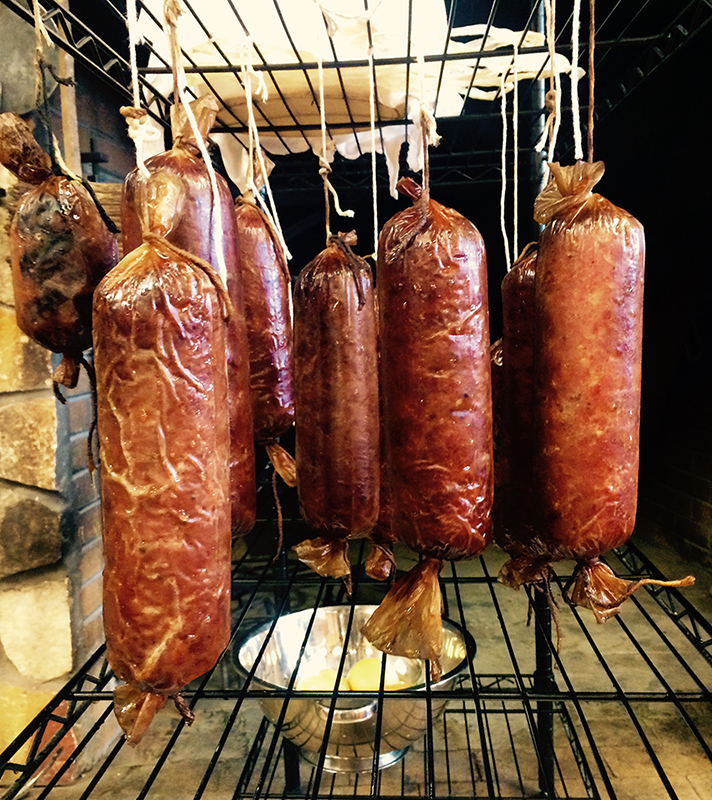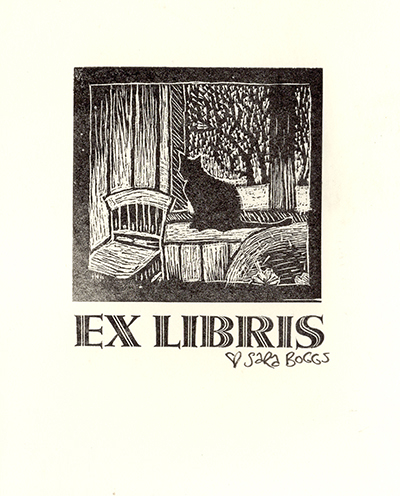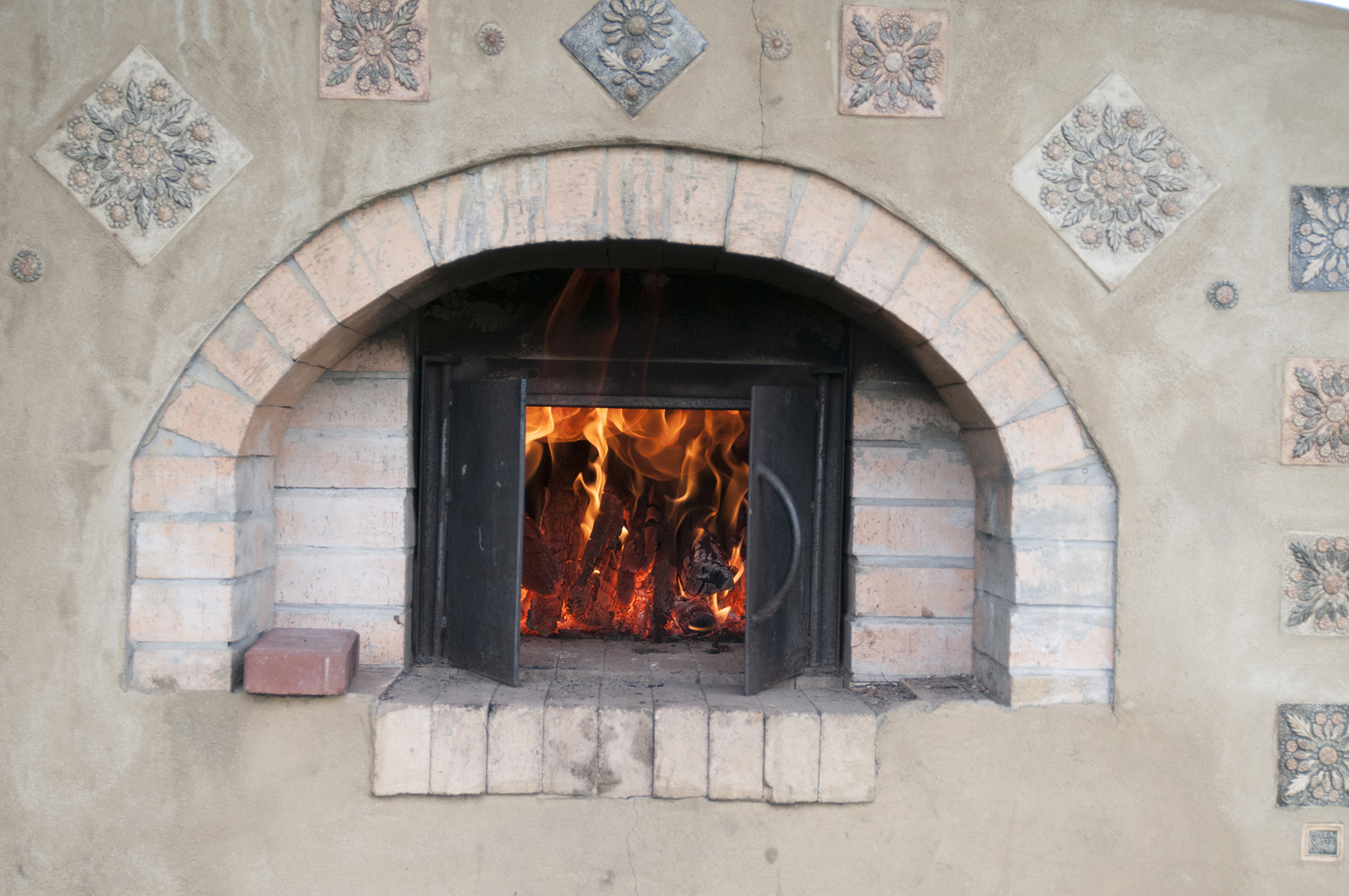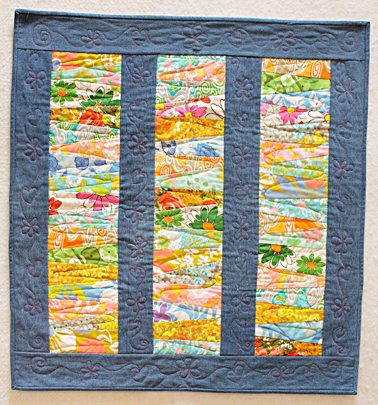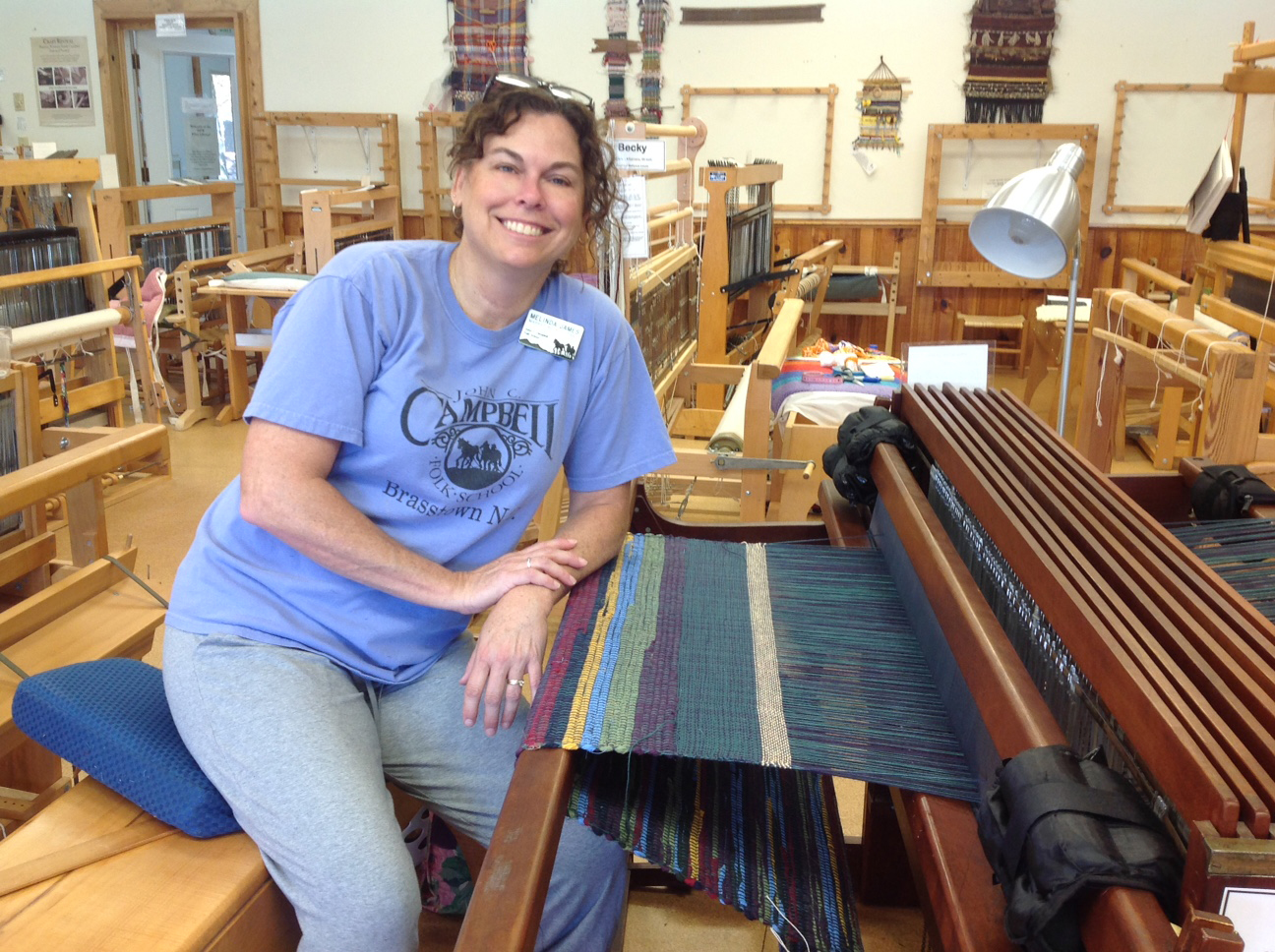
Community
04 Feb So Happy Together at JCCFS: A Couple’s Perspective
[caption id="attachment_12507" align="alignright" width="284"]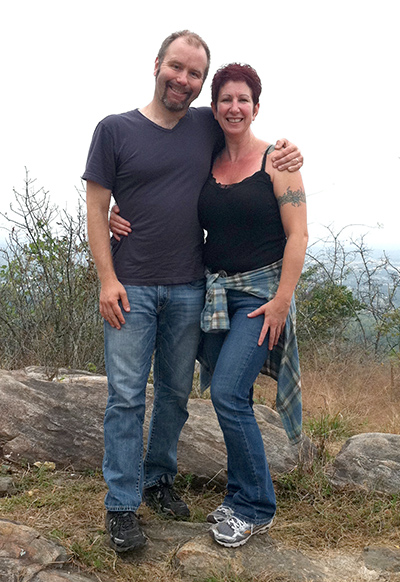 Ivan & Leanne[/caption]
I met Ivan Ewert in Leatherworking class at the Folk School this past fall. While we were busy cutting and riveting leather in the Wood Carving Studio, Ivan's wife Leanne was just across the way in the Jewelry Studio shaping metal into wearable treasures. This was Leanne and Ivan's second trip to the Folk School together. They were celebrating their 15th anniversary. It was inspirational to see in action how the Folk School is an awesome destination for couples. With V-Day right around the corner, I decided now was a great time to catch up with them about their Folk School experience. Enjoy!
CP: How did you hear about the Folk School?
IE: Leanne is a jewelry artist who subscribes to many art magazines. There was an advert in the back of one of them that grabbed her interest, and when we looked the school up online we knew it was something we had to do together.
LE: I had been looking at that advertisement for sometime and when I finally mentioned it to Ivan, he was just as excited about the adventure as I was!
CP: Why did you decide it would be a fun place to come as a couple?
IE: We rarely vacation apart, so if one was going, the other was too! Leanne's interest in learning new skills to apply to her career was inspiring. There was a painting class taking place at the same time as the classes she wanted to take, and a week painting in the mountains sounded like a wonderful retreat.
[caption id="attachment_12505" align="aligncenter" width="480"]
Ivan & Leanne[/caption]
I met Ivan Ewert in Leatherworking class at the Folk School this past fall. While we were busy cutting and riveting leather in the Wood Carving Studio, Ivan's wife Leanne was just across the way in the Jewelry Studio shaping metal into wearable treasures. This was Leanne and Ivan's second trip to the Folk School together. They were celebrating their 15th anniversary. It was inspirational to see in action how the Folk School is an awesome destination for couples. With V-Day right around the corner, I decided now was a great time to catch up with them about their Folk School experience. Enjoy!
CP: How did you hear about the Folk School?
IE: Leanne is a jewelry artist who subscribes to many art magazines. There was an advert in the back of one of them that grabbed her interest, and when we looked the school up online we knew it was something we had to do together.
LE: I had been looking at that advertisement for sometime and when I finally mentioned it to Ivan, he was just as excited about the adventure as I was!
CP: Why did you decide it would be a fun place to come as a couple?
IE: We rarely vacation apart, so if one was going, the other was too! Leanne's interest in learning new skills to apply to her career was inspiring. There was a painting class taking place at the same time as the classes she wanted to take, and a week painting in the mountains sounded like a wonderful retreat.
[caption id="attachment_12505" align="aligncenter" width="480"]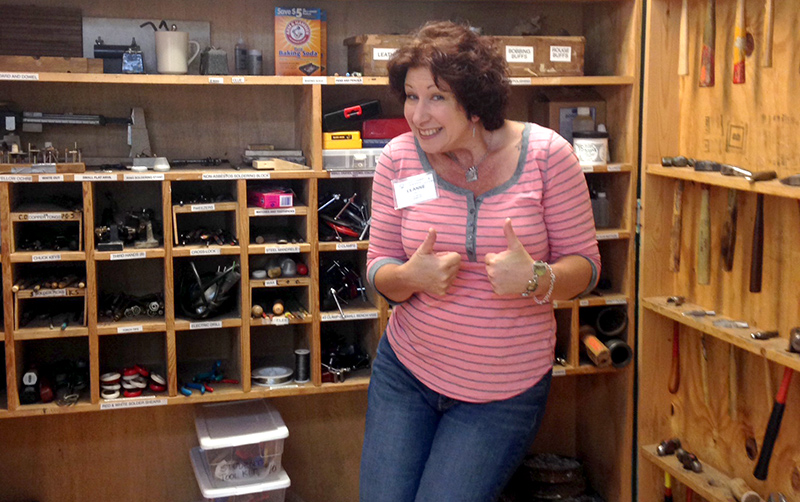 Leanne's "Mecca"- the vast supply closet in the Folk School Jewelry Studio.[/caption]
LE: I work out of my home studio and it can become a very solitary/insular life if one is not careful. The opportunity to be surrounded by, and learn from, other creatives that work in my chosen field sounded fabulous and I immediately wanted to go. I was born and raised in the south, so any chance I have to go back home is always a big treat for me. This is the best of both worlds AND I get to share it with the person I love. This last trip was our anniversary gift to one another!
CP: How many times have you come to the Folk School? What classes have you taken?
IE: Only twice so far, and never a class together. Leanne's focused on jewelry but branched into leatherwork with Donna Wiggins this year. I've taken painting, leatherwork, and The Art of Smoke... all of my classes have been a real treat.
LE: The first time we came down, I took a week-long wire wrapping class with Judy Peppers. This last time, I was getting more advanced instructions in Metalsmithing with Tom And Kay Benham for my week course and then onto a much-too short weekend session with Donna Wiggins for beginner work in leather...LOVED IT!!!
Leanne's "Mecca"- the vast supply closet in the Folk School Jewelry Studio.[/caption]
LE: I work out of my home studio and it can become a very solitary/insular life if one is not careful. The opportunity to be surrounded by, and learn from, other creatives that work in my chosen field sounded fabulous and I immediately wanted to go. I was born and raised in the south, so any chance I have to go back home is always a big treat for me. This is the best of both worlds AND I get to share it with the person I love. This last trip was our anniversary gift to one another!
CP: How many times have you come to the Folk School? What classes have you taken?
IE: Only twice so far, and never a class together. Leanne's focused on jewelry but branched into leatherwork with Donna Wiggins this year. I've taken painting, leatherwork, and The Art of Smoke... all of my classes have been a real treat.
LE: The first time we came down, I took a week-long wire wrapping class with Judy Peppers. This last time, I was getting more advanced instructions in Metalsmithing with Tom And Kay Benham for my week course and then onto a much-too short weekend session with Donna Wiggins for beginner work in leather...LOVED IT!!!
22 Dec The Wonderful Illustrated World of Host Sara Boggs
Posted at 13:15h
in Stories: Book Arts, Stories: Drawing, Stories: Painting, Stories: Paper Art, Work/Study & Host Program 5 Comments
[caption id="attachment_12188" align="aligncenter" width="600"]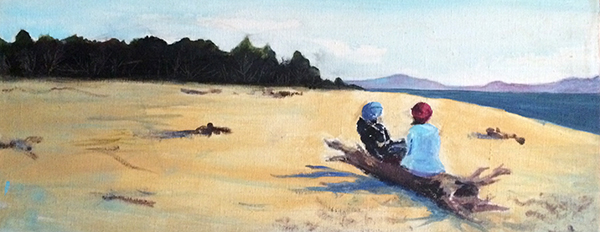 Painting by Sara Boggs[/caption]
Every time I see Sara Boggs around campus, like a giddy child, I ask her: "Can I see your sketchbook?" She always says "yes." You see, Sara is one of those artists who constantly carries her handmade sketchbook around, capturing tiny moments of life here and there - taking the time to practice and develop her drawing ability everyday. It has been incredible to see her book grow with the faces, places, and the spirit of the Folk School during her host term this fall. She permitted me to scan in some pages from her book to share with you. We also sat down over cookies and tea to talk about her experience as host and artistic journaler.
[caption id="attachment_12174" align="alignright" width="229"]
Painting by Sara Boggs[/caption]
Every time I see Sara Boggs around campus, like a giddy child, I ask her: "Can I see your sketchbook?" She always says "yes." You see, Sara is one of those artists who constantly carries her handmade sketchbook around, capturing tiny moments of life here and there - taking the time to practice and develop her drawing ability everyday. It has been incredible to see her book grow with the faces, places, and the spirit of the Folk School during her host term this fall. She permitted me to scan in some pages from her book to share with you. We also sat down over cookies and tea to talk about her experience as host and artistic journaler.
[caption id="attachment_12174" align="alignright" width="229"]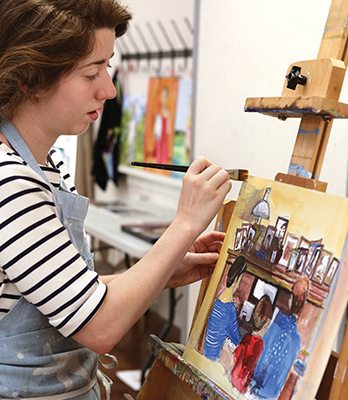 Sara in the Folk School Painting Studio[/caption]
CP: You were recently a character in the night of Holiday Revelry hosted by David Vowell. Who did you play?
SB: I got to play a couple of different characters: an all around reveler drinking wassail, the Little Pickle Boy in one of the tales about St. Nicholas, and Jack the Green in the mummer’s play. Jack’s character is traditionally full of mischief! In our play, Jack the Green saves the day in the story of St. George and the Dragon.
CP: Very nice. So you are wrapping up your host term at the Folk School? What's been your favorite part of being host?
SB: It’s the people… it’s for sure the people. Every week, I get to meet all of these wonderful people with amazing stories and wonderful things that they have done. They are all so sweet and encouraging – they make me feel like this world we have here that’s not quite real life – this fairy tale world that’s all fiddle music and blacksmith coal – is something that we can carry always. It’s been really wonderful to meet them all.
CP: Do you have any specific memories that resonate with you?
SB: There have been quite a few. Maybe it was because it was so early on in my time here, but one that sticks out is a magical cooking class dinner party. The class was a wood fired cooking class and they had their Thursday night dinner outside on picnic tables, with candle light torches. There was wine, and ukelele music, and a beautiful pink sunset overhead… little dogs came wandering through. It was slow and delicious. I wasn’t even supposed to be there, I was just crashing, but they let me crash. It was a lovely evening and I felt like it was the right way to start off my foot here.
[caption id="attachment_12175" align="aligncenter" width="600"]
Sara in the Folk School Painting Studio[/caption]
CP: You were recently a character in the night of Holiday Revelry hosted by David Vowell. Who did you play?
SB: I got to play a couple of different characters: an all around reveler drinking wassail, the Little Pickle Boy in one of the tales about St. Nicholas, and Jack the Green in the mummer’s play. Jack’s character is traditionally full of mischief! In our play, Jack the Green saves the day in the story of St. George and the Dragon.
CP: Very nice. So you are wrapping up your host term at the Folk School? What's been your favorite part of being host?
SB: It’s the people… it’s for sure the people. Every week, I get to meet all of these wonderful people with amazing stories and wonderful things that they have done. They are all so sweet and encouraging – they make me feel like this world we have here that’s not quite real life – this fairy tale world that’s all fiddle music and blacksmith coal – is something that we can carry always. It’s been really wonderful to meet them all.
CP: Do you have any specific memories that resonate with you?
SB: There have been quite a few. Maybe it was because it was so early on in my time here, but one that sticks out is a magical cooking class dinner party. The class was a wood fired cooking class and they had their Thursday night dinner outside on picnic tables, with candle light torches. There was wine, and ukelele music, and a beautiful pink sunset overhead… little dogs came wandering through. It was slow and delicious. I wasn’t even supposed to be there, I was just crashing, but they let me crash. It was a lovely evening and I felt like it was the right way to start off my foot here.
[caption id="attachment_12175" align="aligncenter" width="600"]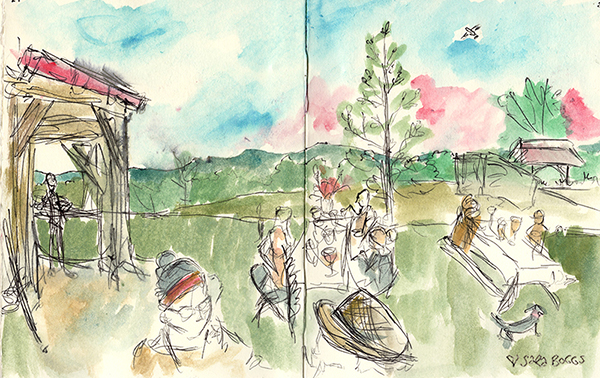 Page from Sara's sketchbook: Thursday night dinner party for the Cooking Class[/caption]
Page from Sara's sketchbook: Thursday night dinner party for the Cooking Class[/caption]
16 Dec Wood Fired Cooking: Falling in Love with Falling Heat
[caption id="attachment_12123" align="aligncenter" width="599"]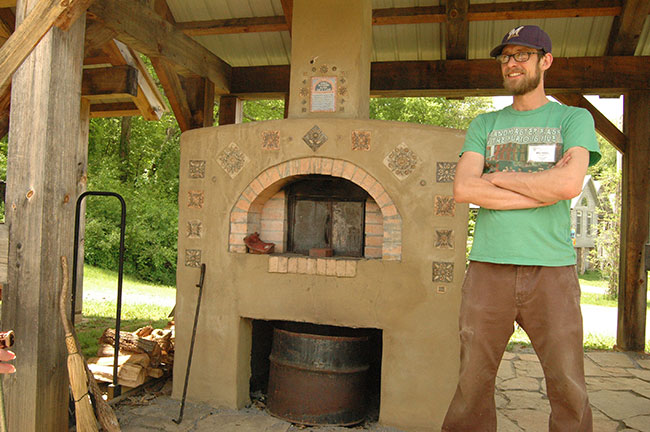 Student Matt waits in front of the outdoor wood fired oven adjacent to the Cooking Studio while his artisan loaves bake.[/caption]
[caption id="attachment_12128" align="alignright" width="202"]
Student Matt waits in front of the outdoor wood fired oven adjacent to the Cooking Studio while his artisan loaves bake.[/caption]
[caption id="attachment_12128" align="alignright" width="202"]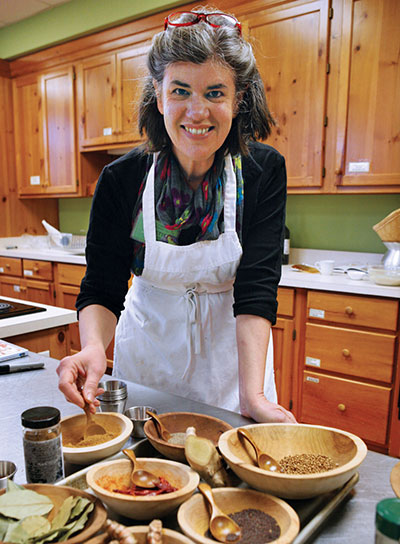 Nanette in the Cooking Studio[/caption]
Love the magic and allure of the wood fired flame? Do you savor the flavor of food cooked in a brick oven? The Cooking Studio at the John C. Campbell Folk School has not one, but two, wood fired brick ovens for students to bake all sorts of savory and sweet treats, from flatbreads and loaves, to roasted meats, fish & vegetables, to delicious curries & stews, and even pies, cakes & gingerbread cookies.
In 1998, when I was asked to become the first Resident Artist for Cooking at the Folk School, I was eager to learn the art of wood fired baking in our brand new Woodstone Domed Pizza Oven which was installed in the Cooking Studio on the ground floor of Davidson Hall. We recognized the growing revival of interest in wood fired baking and we wanted to make these techniques available to our own community. A few years later, we added the second outdoor student-built oven, housed under a student-built timber-framed pavilion. Clay instructor, Mary Dashiell and her husband John designed and led the construction of that oven.
Nanette in the Cooking Studio[/caption]
Love the magic and allure of the wood fired flame? Do you savor the flavor of food cooked in a brick oven? The Cooking Studio at the John C. Campbell Folk School has not one, but two, wood fired brick ovens for students to bake all sorts of savory and sweet treats, from flatbreads and loaves, to roasted meats, fish & vegetables, to delicious curries & stews, and even pies, cakes & gingerbread cookies.
In 1998, when I was asked to become the first Resident Artist for Cooking at the Folk School, I was eager to learn the art of wood fired baking in our brand new Woodstone Domed Pizza Oven which was installed in the Cooking Studio on the ground floor of Davidson Hall. We recognized the growing revival of interest in wood fired baking and we wanted to make these techniques available to our own community. A few years later, we added the second outdoor student-built oven, housed under a student-built timber-framed pavilion. Clay instructor, Mary Dashiell and her husband John designed and led the construction of that oven.
15 Dec Inteview with Carl Dreher on Music, Dance,, and Brasstown
[caption id="attachment_12103" align="aligncenter" width="602"]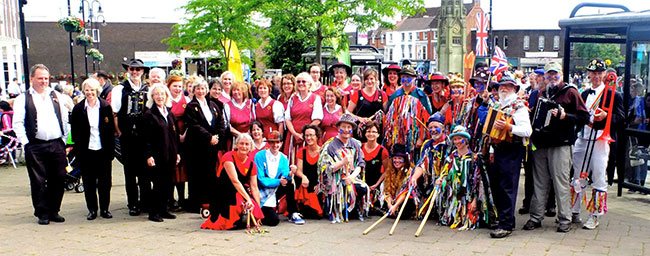 The Brasstown Morris Teams in England. (Carl and his red trombone are on the far right.)[/caption]
There are all sorts of traditions that are alive and well at the Folk School. The Brasstown Fire Department always brings the firetruck to spray down all the children during Little/Middle Folk School, we always dance the Salty Dog Rag during the evening break at Saturday night dances, and the Brasstown Brigade always helps us bring in the New Year with their black powder muskets. One of my favorite Folk School traditions is the Brasstown Follies, the talent show that happens each Winter Dance Week the night before New Years Eve. For as long as I've been coming to Winter Dance Week, the Follies have been organized and MC'ed by Carl Dreher - dancer, musician, magician, and all around Brasstown enthusiast. So enthusiastic, in fact, that he and his wife Charlotte Bristow recently retired and decided to move here from Texas. Let's meet Carl...
[caption id="attachment_12107" align="alignright" width="253"]
The Brasstown Morris Teams in England. (Carl and his red trombone are on the far right.)[/caption]
There are all sorts of traditions that are alive and well at the Folk School. The Brasstown Fire Department always brings the firetruck to spray down all the children during Little/Middle Folk School, we always dance the Salty Dog Rag during the evening break at Saturday night dances, and the Brasstown Brigade always helps us bring in the New Year with their black powder muskets. One of my favorite Folk School traditions is the Brasstown Follies, the talent show that happens each Winter Dance Week the night before New Years Eve. For as long as I've been coming to Winter Dance Week, the Follies have been organized and MC'ed by Carl Dreher - dancer, musician, magician, and all around Brasstown enthusiast. So enthusiastic, in fact, that he and his wife Charlotte Bristow recently retired and decided to move here from Texas. Let's meet Carl...
[caption id="attachment_12107" align="alignright" width="253"]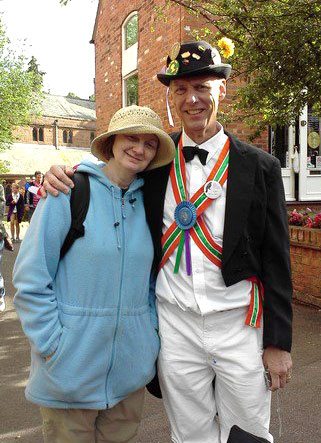 Carl & Charlotte at Kenilworth Castle.
Carl & Charlotte at Kenilworth Castle. Photo by Julie B. Hearne.[/caption] CC: When did you first start coming to the Folk School? Was it for Winter Dance Week, or to take another class? CD: I believe it was 1993. I saw an ad for Winter Dance Week in the Country Dance & Song Society (CDSS) newsletter, and saw that Bob Dalsemer (the Music and Dance Coordinator at the Folk School at the time) was in charge. I knew Bob from serving on the Board of CDSS, and that was all the recommendation I needed to know that it would be a fun week. So I loaded up my truck and drove out. Except for one year when my wife Charlotte and I decided to stay home for Christmas (a big mistake, I SO missed everyone!) and one year when I was sick, we've been coming continuously since then. CC: Tell us about your interest in music and dance? What musical instruments do you play and what kinds of dance have you done? CD: I've always had music in my life, with my parent's encouragement. Neither of them played any instruments that I can remember, although I still have my dad's harmonica. My parents loved German music and bought my brother an accordion...is that child abuse?...but he didn't take to it, so I picked it up. (Not easy...it was a full 120-bass "Billy Baldwin" Har-har.) I started the trombone in 7th grade. (My parent's reaction was "What? The trombone?! But you have an accordion!") I continued playing it all the way through college and then grad school at the University of Virginia. There was a very fine concertina player at U.Va., which inspired me later to buy an instrument and some books and learn it. The melodeon came next out of necessity, since I wanted to start a Cotswold Morris side and I was the only musician (that's being self-flattering) in the group. Next on the list are the banjo and the ukelele, which are hiding in a closet, waiting to be unleashed on the unsuspecting world. I intend to make use of Folk School classes to get started on those. Wow, accordion, trombone and banjo. The Big Three of social-pariah instruments.
25 Nov Time to Quilt! An Interview with Audrey Hiers
I had the pleasure of having my first ever Folk School Quilting class taught by one firecracker of a quilter, Audrey Hiers of Blairsville, GA. This lovely lady has been picked to be featured in McCall's "Quilting” Magazine 6 times and her "Crazy Dazies” designs is a McCall's pick of their top 16 scrap quilts. She is teaching “Appalachian Holiday Quilts" during Holiday in the Mountains Week, December 7-13. I caught up with Audrey about quilting and more. Enjoy our chat! [caption id="attachment_12026" align="aligncenter" width="600"]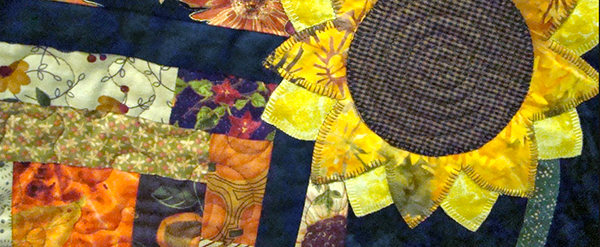 Detail of "It's Fall, Y'all: Fun Scrappy Autumn Quilt" by Audrey Hiers[/caption]
[caption id="attachment_12018" align="alignright" width="227"]
Detail of "It's Fall, Y'all: Fun Scrappy Autumn Quilt" by Audrey Hiers[/caption]
[caption id="attachment_12018" align="alignright" width="227"]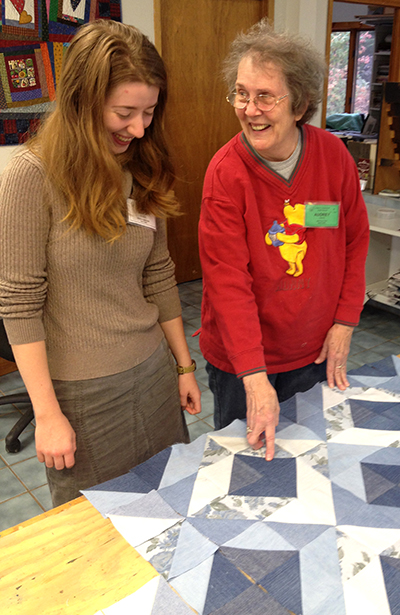 Audrey teaches Sara about quilt design in the Folk School Quilting Studio.[/caption]
CP: How did you get so involved in the quilting world?
AH: Probably because of the quilting genes in the family. Both of my grandmothers quilted and although I never saw either of them at the frame, I do believe in heredity! You could say I fell into it, and once I tried it, I got hooked big time. I seriously started quilting in the early 80s and taught my first class in 1987.
CP: Has quilting changed since then?
Comparing quilting 1980s to now is like the difference between night and day. For the most part we still use fabric and that's about it.
CP: What’s your favorite holiday motif?
AH: My favorite holiday motif is a sprig of freshly cut pine with holly sprigs mixed in. Alone, it would be a holly leaf.
CP: How is Appalachian style quilting different from quilting in other regions? Does it have any distinctive characteristics?
Audrey teaches Sara about quilt design in the Folk School Quilting Studio.[/caption]
CP: How did you get so involved in the quilting world?
AH: Probably because of the quilting genes in the family. Both of my grandmothers quilted and although I never saw either of them at the frame, I do believe in heredity! You could say I fell into it, and once I tried it, I got hooked big time. I seriously started quilting in the early 80s and taught my first class in 1987.
CP: Has quilting changed since then?
Comparing quilting 1980s to now is like the difference between night and day. For the most part we still use fabric and that's about it.
CP: What’s your favorite holiday motif?
AH: My favorite holiday motif is a sprig of freshly cut pine with holly sprigs mixed in. Alone, it would be a holly leaf.
CP: How is Appalachian style quilting different from quilting in other regions? Does it have any distinctive characteristics?
17 Nov In the Print Studio with Jim Horton
Posted at 12:24h
in Instructor Voices, Stories: Book Arts, Stories: Paper Art, Stories: Printmaking 1 Comment
[caption id="attachment_11908" align="aligncenter" width="600"]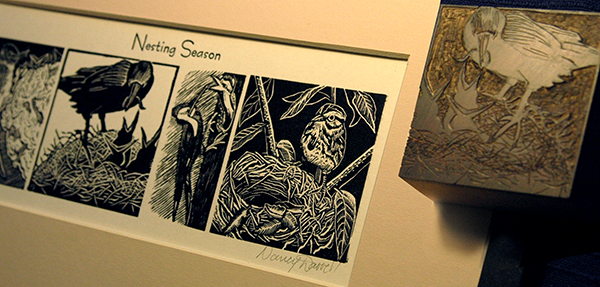 Student print and block project created in Jim Horton's Wood Engraving class at the Folk School[/caption]
I recently talked with instructor Jim Horton about printmaking, wood engraving, his upcoming classes and the new Book and Paper Arts Studio. Jim has been a printmaking/graphic design instructor for 43 years, with special interest in historic graphic tools and processes. His work ranges from job printing and book arts to limited-edition prints. Enjoy our interview!
[caption id="attachment_11904" align="alignright" width="285"]
Student print and block project created in Jim Horton's Wood Engraving class at the Folk School[/caption]
I recently talked with instructor Jim Horton about printmaking, wood engraving, his upcoming classes and the new Book and Paper Arts Studio. Jim has been a printmaking/graphic design instructor for 43 years, with special interest in historic graphic tools and processes. His work ranges from job printing and book arts to limited-edition prints. Enjoy our interview!
[caption id="attachment_11904" align="alignright" width="285"]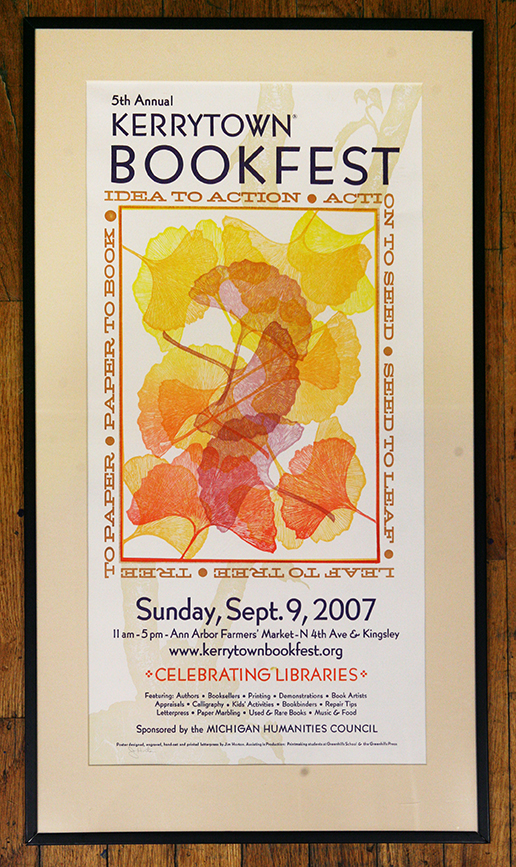 Poster by Jim Horton[/caption]
CP: Where are you from?
JH: I was born in Oklahoma, but lived most of my life in Ann Arbor, Michigan. Midwesterner to the bone, but I sure like to visit the South.
CP: Tell me about your history with printmaking?
JH: My father was a sign painter, the old fashioned kind using a brush and gold leaf. It was an incredible skill. He also did silk screen printing back when the fabric was real silk. He cut stencils by hand. So graphic arts was always highly respected on our family culture. Making woodblock prints was way cool. As a college student in art school, naturally, I gravitated to the printmaking studio. I was at home there. I loved the industriousness of proofing an edition of prints on fine paper.
CP: What do you do when you are not in Brasstown?
JH: I was an art teacher, and at every level, teaching graphic design, studio art.. all mediums. That and always printing. A few years back I deeply got into letterpress and engraving. I live in a rural area, and love working outdoors, walking and doing yoga. I still love to draw too. I go over to the local universities and draw from life (models).
[caption id="attachment_11906" align="aligncenter" width="480"]
Poster by Jim Horton[/caption]
CP: Where are you from?
JH: I was born in Oklahoma, but lived most of my life in Ann Arbor, Michigan. Midwesterner to the bone, but I sure like to visit the South.
CP: Tell me about your history with printmaking?
JH: My father was a sign painter, the old fashioned kind using a brush and gold leaf. It was an incredible skill. He also did silk screen printing back when the fabric was real silk. He cut stencils by hand. So graphic arts was always highly respected on our family culture. Making woodblock prints was way cool. As a college student in art school, naturally, I gravitated to the printmaking studio. I was at home there. I loved the industriousness of proofing an edition of prints on fine paper.
CP: What do you do when you are not in Brasstown?
JH: I was an art teacher, and at every level, teaching graphic design, studio art.. all mediums. That and always printing. A few years back I deeply got into letterpress and engraving. I live in a rural area, and love working outdoors, walking and doing yoga. I still love to draw too. I go over to the local universities and draw from life (models).
[caption id="attachment_11906" align="aligncenter" width="480"]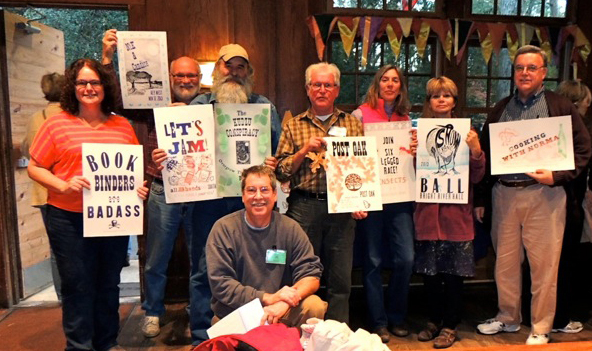 Class photo and projects from Jim's class: "The Art of the Great American Poster"[/caption]
CP: How long have you been coming to/teaching at the Folk School?
JH: I want to say about seven years. Dea Sasso got me here, and she was right. People like the Pattersons, we can only get down here in these hills.
[caption id="attachment_11910" align="alignright" width="480"]
Class photo and projects from Jim's class: "The Art of the Great American Poster"[/caption]
CP: How long have you been coming to/teaching at the Folk School?
JH: I want to say about seven years. Dea Sasso got me here, and she was right. People like the Pattersons, we can only get down here in these hills.
[caption id="attachment_11910" align="alignright" width="480"]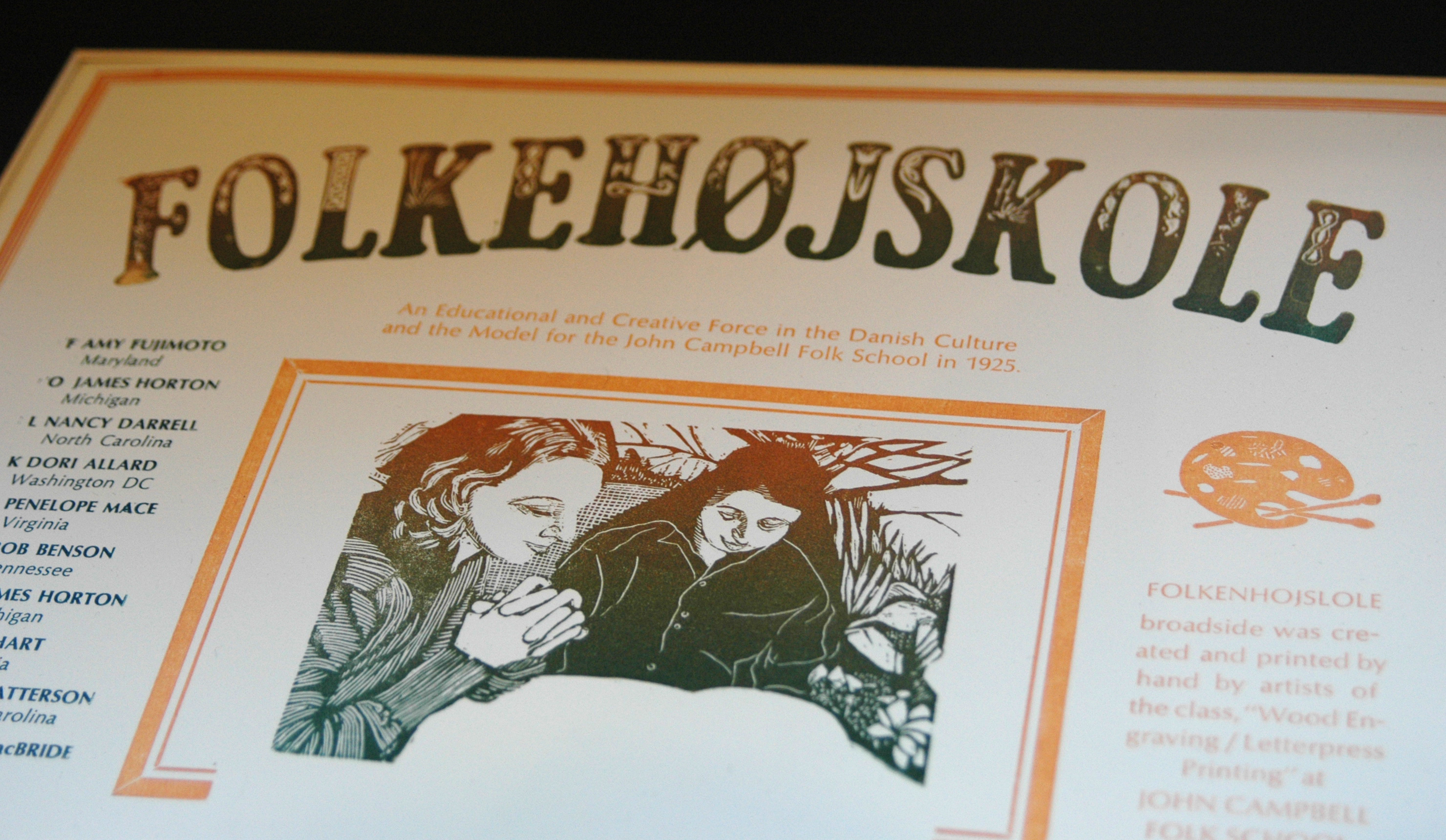 Folkehøjskole print by Jim Horton and illustrations by Nancy Darrell[/caption]
CP: What are projects are you working on currently? Where do you draw inspirations from?
JH: I am illustrating and printing a book of traditional folk songs. I love cowboy songs...why? I don't know. I also love old gospel, though I am not the least bit religious in a doctrinal sense.
Folkehøjskole print by Jim Horton and illustrations by Nancy Darrell[/caption]
CP: What are projects are you working on currently? Where do you draw inspirations from?
JH: I am illustrating and printing a book of traditional folk songs. I love cowboy songs...why? I don't know. I also love old gospel, though I am not the least bit religious in a doctrinal sense.
23 Oct Weaving Fascination by Melinda James
...
17 Oct Bell, Hook & Anvil: Auction Talk
I stopped by the Oscar Cantrell Blacksmith Shop, the current shop of Resident Blacksmith, Paul Garrett. Paul and I talked about the upcoming Blacksmith & Fine Craft Auction on November 1, a special event planned for October 31st, and about Folk School life in general. Enjoy! [caption id="attachment_11679" align="aligncenter" width="600" class=" "]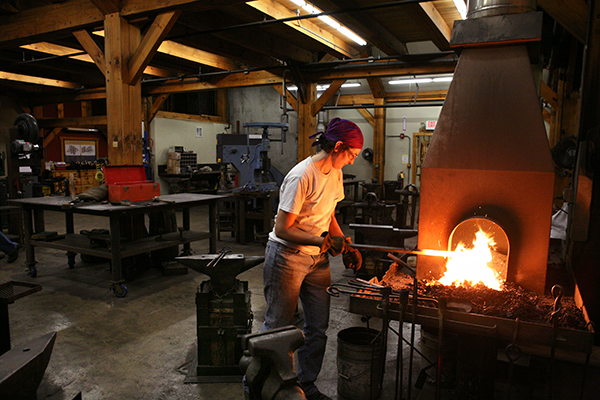 See blacksmiths in action forging items in the Clay Spencer Blacksmith Shop on October 31 at 7 p.m. Items created will be auctioned off the following day at the Blacksmith & Fine Craft Auction.[/caption]
CP: So, the Blacksmith & Fine Craft Auction is coming up on November 1. I hear there’s going to be a new special event on Friday night. Can you talk about that?
PG: I can. Traditionally, there has been a joint meeting of the Appalachian Area Chapter of Blacksmiths (AACB) and NC ABANA at the Folk School during the auction weekend. The meeting is on Saturday morning, bright and early.
[caption id="attachment_11683" align="alignright" width="320"]
See blacksmiths in action forging items in the Clay Spencer Blacksmith Shop on October 31 at 7 p.m. Items created will be auctioned off the following day at the Blacksmith & Fine Craft Auction.[/caption]
CP: So, the Blacksmith & Fine Craft Auction is coming up on November 1. I hear there’s going to be a new special event on Friday night. Can you talk about that?
PG: I can. Traditionally, there has been a joint meeting of the Appalachian Area Chapter of Blacksmiths (AACB) and NC ABANA at the Folk School during the auction weekend. The meeting is on Saturday morning, bright and early.
[caption id="attachment_11683" align="alignright" width="320"]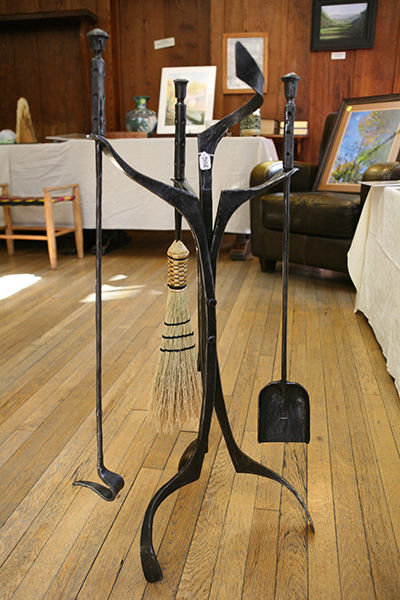 Fire place set forged at the "Hammer In" 2013[/caption]
I had been trying to think of a way to expand the meeting and make it more appealing for smiths to stay over on Friday night. Last year, we tried a small invitational Friday night “Hammer In” (A "Hammer In" is where blacksmiths get together and make things collaboratively). It went really well. We made a few things for the auction, including a fireplace set, and it was encouraging enough to try it again this year.
I put the word out to members of the blacksmith chapters and we are expecting quite a few smiths on the evening of October 31st. We are opening the shop up to auction goers to come and see what’s involved in the work and to observe how the items are handcrafted. I believe it will add value and interest to the pieces if folks can see the forging process.
Tim Ryan is going to have a kettle of cooked goodness to offer up for a small cost per bowl. It’s gonna be fun! We are going to have a few set projects: a fire tools set and maybe a sculptural piece. Blacksmiths can forge smaller items too. It’ll be a good crowd.
Fire place set forged at the "Hammer In" 2013[/caption]
I had been trying to think of a way to expand the meeting and make it more appealing for smiths to stay over on Friday night. Last year, we tried a small invitational Friday night “Hammer In” (A "Hammer In" is where blacksmiths get together and make things collaboratively). It went really well. We made a few things for the auction, including a fireplace set, and it was encouraging enough to try it again this year.
I put the word out to members of the blacksmith chapters and we are expecting quite a few smiths on the evening of October 31st. We are opening the shop up to auction goers to come and see what’s involved in the work and to observe how the items are handcrafted. I believe it will add value and interest to the pieces if folks can see the forging process.
Tim Ryan is going to have a kettle of cooked goodness to offer up for a small cost per bowl. It’s gonna be fun! We are going to have a few set projects: a fire tools set and maybe a sculptural piece. Blacksmiths can forge smaller items too. It’ll be a good crowd.
15 Oct Charlotte Crittenden on Dance Calling
I stopped by the Yarn Circle to speak with Charlotte Crittenden to talk about calling and dancing. Charlotte, a Brasstown local, is a regular caller at the Folk School on Tuesday and Saturday night dances. She is a popular regional caller who has recently called at Old Farmer's Ball, River Falls, Grey Eagle, Chattanooga, Atlanta, Charleston, Charlotte, Sautee and more! Enjoy our interview... [caption id="attachment_11663" align="aligncenter" width="600"]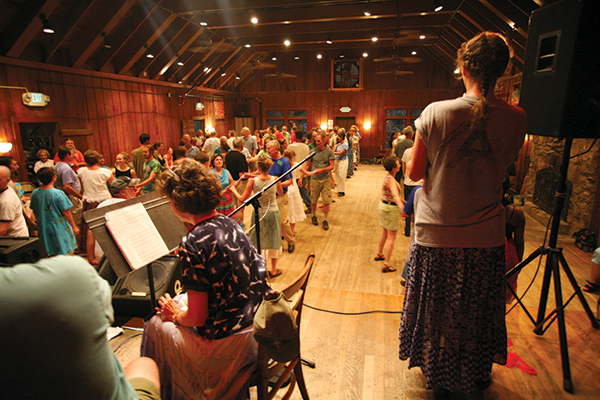 Charlotte calls a contra dance in the Community Room.[/caption]
CP: How long have you been calling at the Folk School?
CC: I came to the Folk School as a Work/Study in the winter of 2006 and I took Bob Dalsemer’s Dance Callers' Workshop that summer. So technically I’ve been calling since 2006, but I wasn’t calling regularly 'till a little time after that.
CP: Why did you get into dance calling?
CC: I’d been a contra dancer for a long time. When I was in elementary, high school and college I was involved in other kinds of dance, so I’ve always had a history of being interested in dancing. I wanted to be a provider of the activity as opposed to just a consumer. Recognizing that my skills as a musician might be a little lacking (laughs), I embraced calling as the next fun way I could be able to do that.
[caption id="attachment_11666" align="alignright" width="340"]
Charlotte calls a contra dance in the Community Room.[/caption]
CP: How long have you been calling at the Folk School?
CC: I came to the Folk School as a Work/Study in the winter of 2006 and I took Bob Dalsemer’s Dance Callers' Workshop that summer. So technically I’ve been calling since 2006, but I wasn’t calling regularly 'till a little time after that.
CP: Why did you get into dance calling?
CC: I’d been a contra dancer for a long time. When I was in elementary, high school and college I was involved in other kinds of dance, so I’ve always had a history of being interested in dancing. I wanted to be a provider of the activity as opposed to just a consumer. Recognizing that my skills as a musician might be a little lacking (laughs), I embraced calling as the next fun way I could be able to do that.
[caption id="attachment_11666" align="alignright" width="340"]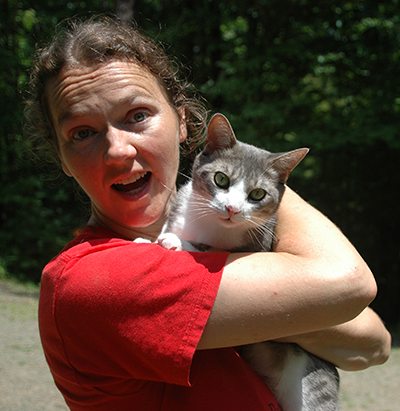 Charlotte & Charlie[/caption]
CP: What’s the best thing about calling a dance at the Folk School?
CC: What a good question! I’d say the dance community at the Folk School is one of the best for integrating all kinds of different folks. People who have been dancing for years and years and years are dancing on the same floor as those who have never ever done it before. Little kids all the way up to folks in their 70s and 80s - all on the same dance floor and everyone’s having a great time, enjoying each other's company. That’s the best part!
CP: Do you have a favorite tune?
CC: I really like the old time tune called Growling & Grumbling, which I love as a dance tune. It got this great low, mumbly beginning and then it busts into this fun, upbeat tune.
CP: Is that the same tune as Growling Old Man and Grumbling Old Woman?
CC: Yep! That’s the one! It a great tune.
CP: Where do you get your dances from?
CC: Oh goodness! Lots of sources. Primarily (and I’d say traditionally) from other callers, but also from going to other dances. I’ll go to a dance and enjoy something that I just danced, run over to the side and write it down real quick.
So I collect dances from dancing. I collect dances from other callers. And in our modern day & age, the internet is a wonderful place, not only to collect dances right off the web, but also to find literature from different places. I use the Country Dance & Song Society which is an organization up in Massachusetts that promotes folk dance and music. I peruse their bookstore pretty frequently. They are a great resource for all things dance.
Charlotte & Charlie[/caption]
CP: What’s the best thing about calling a dance at the Folk School?
CC: What a good question! I’d say the dance community at the Folk School is one of the best for integrating all kinds of different folks. People who have been dancing for years and years and years are dancing on the same floor as those who have never ever done it before. Little kids all the way up to folks in their 70s and 80s - all on the same dance floor and everyone’s having a great time, enjoying each other's company. That’s the best part!
CP: Do you have a favorite tune?
CC: I really like the old time tune called Growling & Grumbling, which I love as a dance tune. It got this great low, mumbly beginning and then it busts into this fun, upbeat tune.
CP: Is that the same tune as Growling Old Man and Grumbling Old Woman?
CC: Yep! That’s the one! It a great tune.
CP: Where do you get your dances from?
CC: Oh goodness! Lots of sources. Primarily (and I’d say traditionally) from other callers, but also from going to other dances. I’ll go to a dance and enjoy something that I just danced, run over to the side and write it down real quick.
So I collect dances from dancing. I collect dances from other callers. And in our modern day & age, the internet is a wonderful place, not only to collect dances right off the web, but also to find literature from different places. I use the Country Dance & Song Society which is an organization up in Massachusetts that promotes folk dance and music. I peruse their bookstore pretty frequently. They are a great resource for all things dance.



